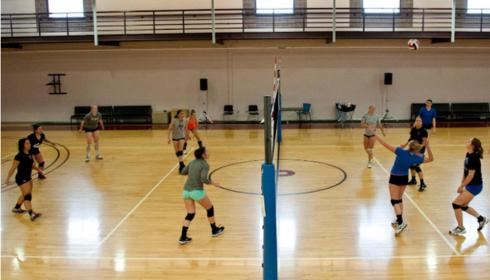Multipurpose sports courts are becoming increasingly popular in schools, housing societies, clubs, and community centers across India. These courts are designed to host a range of activities—basketball, volleyball, badminton, tennis, futsal, and more—on a single surface. The key to creating a safe, high-performance, and long-lasting court lies in choosing the right multi purpose court materials.
This blog will guide you through the most effective outdoor multipurpose court flooring solutions, their costs, pros and cons, and what factors to consider when designing your next multipurpose sport court.
Why Multipurpose Court Flooring Matters
The flooring in a multi sport court needs to strike a fine balance between versatility, safety, durability, and budget. Unlike single-sport surfaces, multipurpose courts are subjected to varying types of movements, equipment use, and impact zones. Therefore, the right multipurpose flooring must provide:
- Shock absorption to reduce injury risk
- Anti-skid properties for various sports
- UV and weather resistance for outdoor use
- Consistent bounce and grip across the entire surface
- Easy maintenance for frequent use
Top Materials for Outdoor Multipurpose Sports Courts
Let’s take a closer look at the most commonly used and recommended materials for multi purpose sports flooring in Indian climates:
1. Synthetic Acrylic Flooring
Overview:
This is one of the most cost-effective and widely used flooring solutions for outdoor courts in India. Installed over a concrete base, acrylic systems consist of multiple layers of textured coating.
Benefits:
- UV-resistant and weatherproof
- Non-slip surface with customizable colors
- Excellent for basketball, tennis, and volleyball
- Low maintenance and easy to resurface
Ideal For:
- Housing society play areas
- School courts
- Government sports complexes
Estimated Cost: ₹350–₹600 per sq. meter
Limitations:
- Not suitable for extremely heavy use or high-impact sports like futsal without added cushioning
- Requires periodic recoating every 4–5 years
2. PU (Polyurethane) Sports Flooring
Overview:
PU flooring is a seamless synthetic option that offers great flexibility and performance. Though more commonly used indoors, advanced formulations now support outdoor use as well.
Benefits:
- Long lifespan with strong abrasion resistance
- Excellent shock absorption and player comfort
- Seamless surface reduces chances of injury
- Multi-sport compatible
Ideal For:
- Semi-professional training courts
- Multi-use school or academy facilities
Estimated Cost: ₹700–₹1200 per sq. meter
Limitations:
- Costlier than acrylic
- Requires expert installation
- Needs proper drainage system underneath
3. Modular Interlocking Tiles
Overview:
These are snap-together high-impact polypropylene or rubber tiles laid over concrete or asphalt bases. They are increasingly popular due to ease of installation and versatility.
Benefits:
- Quick installation and replacement
- Weather-resistant and non-porous
- Suitable for indoor and outdoor use
- Available in bright colors and textured finishes
Ideal For:
- Community centers
- Portable event-based courts
- Multi-sport recreational zones
Estimated Cost: ₹450–₹750 per sq. meter
Limitations:
- May not offer the same professional performance as acrylic or PU
- Requires even surface preparation
- Gaps between tiles can gather dust and require cleaning
Factors to Consider When Choosing Multi Purpose Court Materials
Selecting the right flooring is about more than just price. Here are key elements to factor in:
1. Climate Conditions
If your facility is in a high-rainfall or UV-intense region, prioritize weatherproof materials like synthetic acrylic or UV-stable modular tiles.
2. Foot Traffic and Type of Use
Heavy daily use or tournaments may require high-end PU flooring or dual-layer acrylic systems.
3. Installation Time & Budget
If you’re on a tight schedule or budget, modular tiles or basic acrylic coatings may be the best fit.
4. Maintenance Capacity
Modular tiles are easier to clean and replace individually, while seamless PU flooring may need occasional professional upkeep.
Outdoor Multipurpose Court Construction Tips
To ensure a long-lasting court, the construction process must complement the chosen material:
- Base Preparation: Use a well-compacted concrete base with a slight slope (1–1.5%) for drainage.
- Edge Finishing: Provide strong perimeter boundaries using curbs or edging beams.
- Markings: Use sport-specific markings with UV-stable paints that won’t fade quickly.
- Drainage Planning: Prevent water pooling with proper slope and water outlets.
Multi Sport Court Flooring Comparison Table
| Material | Cost (₹/sq. m) | Best For | Pros | Cons |
| Synthetic Acrylic | ₹350–₹600 | Budget-friendly outdoor courts | UV-resistant, low-maintenance, customizable | Less shock absorption |
| PU Sports Flooring | ₹700–₹1200 | Professional/semi-pro outdoor facilities | Seamless, high-performance, cushioned | Higher cost, expert installation needed |
| Modular Interlocking Tiles | ₹450–₹750 | Community and flexible-use spaces | Portable, easy to install, durable | Less seamless, may trap dust |
Conclusion
Choosing the best materials for outdoor multipurpose sports courts requires a balance of function, cost, and aesthetics. Whether you’re constructing a new facility or resurfacing an old one, focus on materials that offer multi-sport compatibility, weather resistance, and player safety.
- For budget-conscious projects, synthetic acrylic flooring is ideal.
- For long-term, high-performance surfaces, PU flooring offers a premium solution.
A well-planned outdoor multipurpose court with the right multi purpose court materials will not only serve multiple sports efficiently but also enhance community participation and athletic development.

